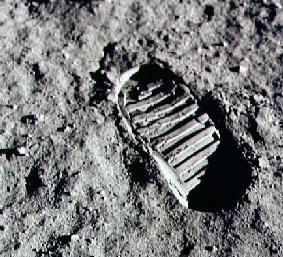|

NASA: AS11-40-5877
|
 This is supposedly the
first footprint on the moon. This is supposedly the
first footprint on the moon.
NASA makes no such claim.
Armstrong did not photograph his first step. The subsequent
activity around the forward footpad would have quickly erased the
first footstep.
This photo was taken at approximately 110:03:00 GET by Buzz Aldrin
as part of an experiment to test the characteristics of lunar soil.
He first photographed the area before the footprint. Then he took a
step forward to make this print, then stepped back again to photograph
it. He also took another photograph nearby with his boot in the
picture after having made the print. [ALSJ, Apollo 11 photo commentary]
 Why does it look like
The toe curls up? Why does it look like
The toe curls up?
The bottom of the print is not planar, as the shadows of the tread
ridges suggest. The lunar surface boots had flexible rubber soles and
adjusted to the contours of the surface like any other footwear.
Buzz took this footprint especially so he could photograph it. He
placed his foot forward, rested his weight on it, and then removed his
foot. Try doing this yourself. Stand upright, take a step forward,
and then pull your foot back. If you do this without consciously
controlling, you'll notice a tendency to push off with your heel.
This would cause the heel to dig in slightly deeper, as we see in this
photograph. The photo bears the characteristics we expect knowing how
it was made. [Ibid.]
 How can a footprint cast
such a big shadow? How can a footprint cast
such a big shadow?
The sun was very low on the horizon. Shadows should appear
exceptionally long. The astronauts reported that their boots
penetrated as little as an eight of an inch (3 mm) to as much as three
inches (7 cm), with an inch being the most common penetration depth
reported. [Reports11b]
At a sun elevation of 9 degrees [NASA document M-932-69-11 (1969),
Table 2] a one-inch (3 cm) deep bootprint should cast a shadow
approximately six inches (15 cm) long on a level, planar surface,
actually longer that what appears in this photo. This
footprint is probably shallower on average than one inch.
 It looks like it's just
sitting there on the ground, not imprinted like it should be, like it
was made of clay and then placed there. It looks like it's just
sitting there on the ground, not imprinted like it should be, like it
was made of clay and then placed there.
Any footprint in a particulate material will displace the material
to all sides. This should be visible in the photograph as a raised
ridge around the print, not that different from the rims of craters.


| 












